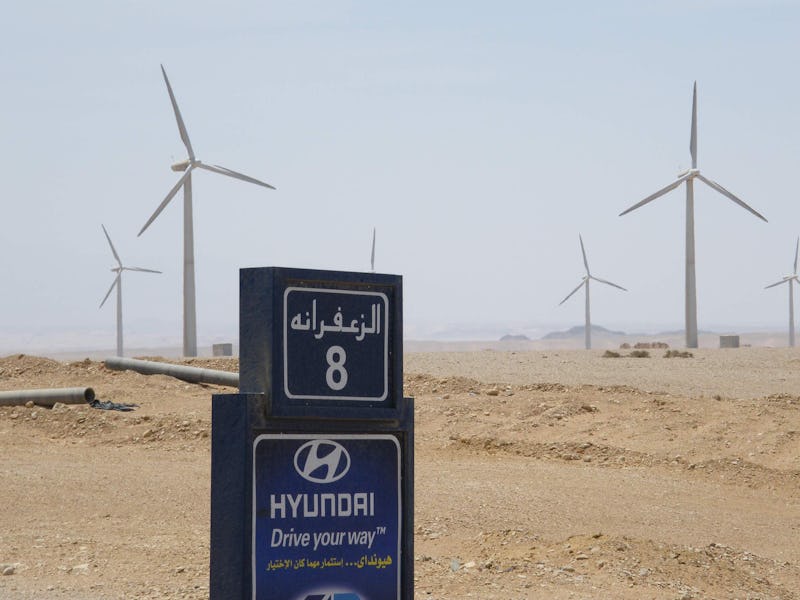Record-Breaking Solar and Wind Farms Are Emerging From the Sands of Egypt
Who could have built these epic structures?

The Egyptian government wants to get 42 percent of its energy sector powered by renewables by 2025, leaving a healthy 5-year window for their 2030 sustainability goals with the United Nations.
In the Western Desert, 400 miles south of Cairo, a solar energy company named KarmSolar is helping them do it. Founded by five friends in a cafe, the company is building what will become a hub of 30 individual power plants with a collective capacity of 1.8 gigawatts of electricity. Located near the Benban village near the Nile, KarmSolar’s complex already employs 4,000 people at the first of 30 facilities, which came online this past November. Once it’s completed, according to the Los Angeles Times, the Benban Solar Park will be the largest solar plant in the world.
A few hundred miles to the east, near Gabal el-Zeit on the coast of the Red Sea, Egypt’s Electricity Ministry have completed preparations for a $670 million wind farm with a 580-megawatt (MW) capacity stemming from 290 turbines. The wind farm will be the “largest in the world” of its kind, according to a spokesperson for Egyptian President Abdel Fattah al-Sisi.
What that means, in specific, as the plant’s manager, Osama Noman, told Egypt Today, is that the facility will be the largest “in terms of area, number of turbines and capacities generated.”
Analysts attribute these massive construction projects to conscious changes made by the Egyptian government’s energy subsidy program, canny outside investment by international aid groups, and the hard work of scrappy, local entrepreneurs.
On the other hand, the size and scope of the projects are so impressive, it’s hard to shake the possibility that other players were involved, particularly in light of Egypt’s illustrious history of extraterrestrial construction. After all, if any human civilization had the technological know-how to make renewable power facilities this large — magically generating hundreds upon hundreds of megawatts of capacity out of thin air — they would have already. Be realistic. Think for yourselves.
Giorgio Tsoukalos, of the History Channel's 'Ancient Aliens" series, whom you already recognize, at the 2016 Alien Con
How Egypt Is Crushing Its Renewable Energy Goals
According to the Los Angeles Times, KarmSolar was built with private investments in the wake of the Arab Spring, after co-founder Ahmen Zahran’s old bosses had fled the country leaving him with a lot of idealism and free time. It began small, marketing solar powered-water pumps to local farmers, living off the grid, and then expanded to provide renewable options to poultry factories and malls.
Public policy played a key role in KarmSolar’s rise as well. In 2016, Egypt’s Central Bank launched a low-interest loan program with the goal of encouraging small business in renewable energy and other key sectors of the economy. They also began scaling back fossil-fuel subsidies in line with an International Monetary Fund-backed reform program. Added with the increasingly more competitive cost of solar and wind equipment worldwide — not to mention Egypt’s sprawling deserts — the project seemed fated.
As solar analyst Benjamin Attia, of the American firm Wood Mackenzie put it, “I can’t think of another example where so many big players have come together to fill the gap.”
It’s an inspiring story of fate and human ingenuity, but it’s only that: a story.
After all, we’re supposed to believe that they have created a automated bird monitoring system to protect migratory birds from flying into turbines at their Gabal el-Zeit complex? That this system uses radar to stop the turbines upon detecting potential impacts? And they did this for only $2.3 million?
Nuh-uh. No. Nobody on Earth could have done this without some pretty high-tech equipment beyond our understanding of physics. I’m sorry. The Aliens who built the pyramids of Giza are back in action.